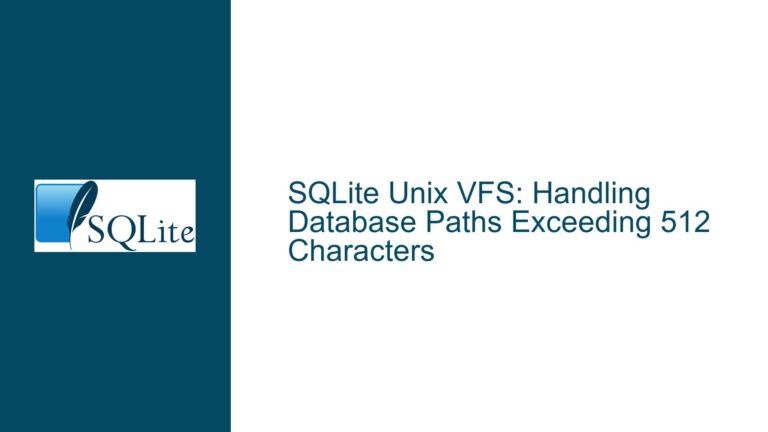Table-Valued Function Encoding Preferences in SQLite
Understanding Table-Valued Function Encoding in SQLite
When working with table-valued functions in SQLite, one of the nuanced challenges developers face is managing text encoding preferences. SQLite, being a lightweight and versatile database engine, supports multiple text encodings, primarily UTF-8 and UTF-16. However, the flexibility in encoding support can sometimes lead to confusion, especially when dealing with table-valued functions that process strings. The core issue revolves around whether it is possible to define a preferred text encoding for a table-valued function, similar to how one might specify encoding preferences for regular user-defined functions.
In SQLite, table-valued functions are implemented using virtual table modules. These modules allow developers to create custom table-like structures that can be queried using SQL. The virtual table module interface provides several callback methods, such as xFilter, which is used to filter rows based on certain criteria. When processing strings within these callback methods, developers often need to handle text encoding conversions, especially when the database encoding differs from the preferred encoding of the function.
The primary concern is that SQLite does not provide a direct mechanism to specify a preferred text encoding for table-valued functions. This means that developers must manually handle text encoding conversions within their virtual table module implementations. While SQLite automatically converts text between UTF-8 and UTF-16 when necessary, this conversion process can introduce overhead, which some developers may wish to avoid for performance reasons.
Exploring the Limitations of Encoding Preferences in Table-Valued Functions
The inability to specify a preferred text encoding for table-valued functions stems from the way SQLite’s virtual table module interface is designed. Unlike regular user-defined functions, where developers can explicitly define different implementations for different encodings, table-valued functions do not have a similar mechanism. This limitation is partly due to the fact that virtual table modules are more complex and involve multiple callback methods, each of which may need to handle text encoding differently.
In the case of regular user-defined functions, SQLite allows developers to register multiple versions of a function, each tailored to a specific text encoding. For example, a developer could register a function that works with UTF-8 encoded strings and another that works with UTF-16 encoded strings. SQLite then automatically selects the appropriate function based on the encoding of the input data. This approach is not feasible for table-valued functions because the virtual table module interface does not provide a way to register multiple encoding-specific implementations.
As a result, developers implementing table-valued functions must rely on SQLite’s internal text conversion mechanisms. When a table-valued function receives a string in a different encoding than expected, SQLite will automatically convert the string to the required encoding. While this automatic conversion ensures that the function works correctly, it can introduce additional processing overhead, especially when dealing with large volumes of text data.
Strategies for Handling Text Encoding in Table-Valued Functions
Given the limitations of SQLite’s virtual table module interface, developers must adopt strategies to manage text encoding in table-valued functions effectively. One approach is to design the function to work with a specific encoding internally and rely on SQLite’s automatic conversion when necessary. This approach simplifies the implementation but may result in performance overhead due to frequent text conversions.
Another strategy is to optimize the function’s implementation to minimize the need for text conversions. For example, if the function primarily processes UTF-8 encoded strings, the developer can ensure that the input data is always in UTF-8 encoding. This can be achieved by setting the database encoding to UTF-8 or by converting the input data to UTF-8 before passing it to the function. By reducing the frequency of text conversions, developers can improve the performance of their table-valued functions.
In some cases, developers may choose to implement custom text conversion logic within their virtual table module. This approach allows for more control over the encoding process and can be tailored to the specific requirements of the function. However, implementing custom text conversion logic can be complex and may introduce additional maintenance overhead.
Ultimately, the choice of strategy depends on the specific requirements of the table-valued function and the performance considerations of the application. Developers must weigh the trade-offs between simplicity, performance, and maintainability when deciding how to handle text encoding in their table-valued functions.
Best Practices for Managing Text Encoding in SQLite Table-Valued Functions
To effectively manage text encoding in SQLite table-valued functions, developers should follow several best practices. First, it is essential to understand the encoding requirements of the function and the data it processes. By clearly defining the expected encoding, developers can design the function to handle text data more efficiently.
Second, developers should leverage SQLite’s automatic text conversion mechanisms when appropriate. While manual text conversion can offer more control, it also introduces complexity and potential sources of error. Relying on SQLite’s built-in conversion capabilities can simplify the implementation and reduce the risk of encoding-related issues.
Third, developers should consider the performance implications of text encoding conversions. When dealing with large volumes of text data, frequent conversions can significantly impact performance. By optimizing the function’s implementation to minimize conversions, developers can improve the overall efficiency of their application.
Finally, developers should document the encoding requirements and handling strategies for their table-valued functions. Clear documentation helps other developers understand the function’s behavior and ensures that any future modifications maintain consistency with the original design.
Conclusion
Managing text encoding in SQLite table-valued functions can be challenging due to the lack of a direct mechanism to specify preferred encodings. However, by understanding the limitations of the virtual table module interface and adopting appropriate strategies, developers can effectively handle text encoding in their functions. Whether relying on SQLite’s automatic conversion mechanisms or implementing custom logic, the key is to balance simplicity, performance, and maintainability. By following best practices and carefully considering the encoding requirements of their functions, developers can ensure that their table-valued functions operate efficiently and reliably in SQLite.






